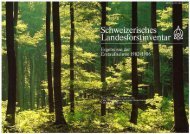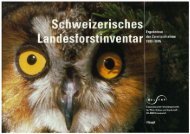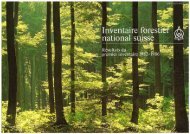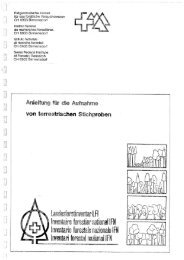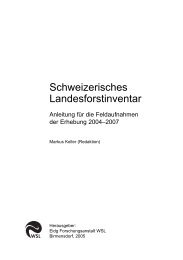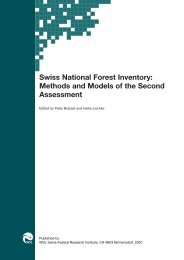30 Jahre Schweizerisches Landesforstinventar - LFI
30 Jahre Schweizerisches Landesforstinventar - LFI
30 Jahre Schweizerisches Landesforstinventar - LFI
Sie wollen auch ein ePaper? Erhöhen Sie die Reichweite Ihrer Titel.
YUMPU macht aus Druck-PDFs automatisch weboptimierte ePaper, die Google liebt.
Das schweizerische <strong>Landesforstinventar</strong> aus<br />
sicht einiger kantone (essay)<br />
robert Häfner<br />
Ulrich Hug<br />
riet Gordon<br />
Davide Bettelini<br />
Hermann Hess<br />
Departement Bau, Verkehr und Umwelt des Kantons Aargau, Abteilung Wald (CH)*<br />
Amt für Wald des Kantons Bern (CH)<br />
Amt für Wald Graubünden (CH)<br />
Sezione forestale cantonale ticinese (CH)<br />
Amt für Landschaft und Natur des Kantons Zürich, Abteilung Wald (CH)<br />
the swiss national Forest inventory from the perspective of some cantons (essay)<br />
Politicians and the general public rightfully expect the forest services to be able to provide information about<br />
the state of the forest and to base their policies on sound data. Public interest in the forest and expectations<br />
that it will provide certain services are today focussing more on superordinate, regional spatial units. Information<br />
above the level of the forest enterprise is becoming increasingly more important and the duties of the forest<br />
services have expanded beyond those associated with single forest enterprises. The Swiss National Forest Inventory<br />
(NFI) was set up as a national instrument, but is also relevant for the cantons. So far, three inventories<br />
have been carried out and the fourth is underway. The cantonal NFI findings have become more relevant during<br />
the past 25 years. But what has the NFI really achieved for the cantons? What are its strengths and weaknesses?<br />
What risks does the fourth NFI entail with its new, continuous method of data collection and what opportunities<br />
does it offer? These questions are addressed here by the authors, who are responsible for forest<br />
planning and for contact with the NFI, in the cantons of Aargau, Bern, the Grisons, Ticino and Zurich. The authors<br />
work in cantons that have always made above average use of the NFI. All apart from Ticino have made the<br />
NFI sampling grid more dense by adding more sampling plots. For these cantons, the NFI has become an indispensable<br />
source of basic information. This article does not, therefore, provide a representative picture of how<br />
the cantons make use of the NFI, but rather reflects how the NFI could potentially serve the cantons.<br />
keywords: Swiss National Forest Inventory, regional inventories, cantons, NFI data use, stakeholders<br />
doi: 10.3188/szf.2011.0282<br />
* Entfelderstrasse 22, CH-5001 Aarau, E-Mail robert.haefner@ag.ch<br />
Das Schweizerische <strong>Landesforstinventar</strong> (<strong>LFI</strong>)<br />
wurde als nationales Instrument konzipiert,<br />
findet aber auch Anwendung bei den Kantonen.<br />
Alle Kantone wurden nach jeder <strong>LFI</strong>-Erhebung<br />
von der Eidgenössischen Forschungsanstalt für<br />
Wald, Schnee und Landschaft (WSL) mit kantonalen<br />
Ergebnissen bedient (<strong>LFI</strong>-Standardangebot). Zudem<br />
bietet die WSL als Dienstleistung spezielle kantonale<br />
Auswertungen an, und sie unterstützt die<br />
Kantone bei der Verdichtung des <strong>LFI</strong>-Netzes zu Kantonalinventuren.<br />
Die Nachfrage der Kantone nach<br />
kantonalen Daten und Auswertungen war beim ersten<br />
<strong>LFI</strong> (<strong>LFI</strong>1) sehr gross: 17 von 26 Kantonen beziehungsweise<br />
Halbkantonen haben solche von der<br />
WSL bezogen. 1 Beim <strong>LFI</strong>2 ist die Nachfrage deutlich<br />
zurückgegangen, was wohl direkt mit der Ausdünnung<br />
der Stichprobendichte – sie wurde halbiert –<br />
zusammenhängen dürfte (Tabelle 1). Für mittelgros se<br />
und kleine Kantone liessen sich dementsprechend<br />
erheblich weniger statistisch gesicherte Aussagen<br />
machen. Mit dem Übergang zum kontinuierlichen<br />
Erhebungsmodus scheint sich das <strong>LFI</strong>4 nach Meinung<br />
der Autoren definitiv zum nationalen Instrument<br />
zu entwickeln, das nur noch Aussagen zur ganzen<br />
Schweiz und mit Einschränkungen für die<br />
Produktionsregionen zulässt. Demgegenüber zeigen<br />
die jüngsten Erhebungen der Arbeitsgruppe Waldplanung<br />
und -management des Schweizerischen<br />
Forstvereins, dass die kantonalen <strong>LFI</strong>-Ergebnisse im<br />
Verlaufe der letzten 25 <strong>Jahre</strong> stetig an Bedeutung<br />
und Anwendung gewonnen haben. 2<br />
1 BräNDLI UB, ULMEr U (2011) Nutzung von <strong>LFI</strong>-Produkten<br />
und WSL-Dienstleistungen durch die Kantone. Ergebnisse aus<br />
einer internen Analyse von Dienstleistungsauswertungen und<br />
der Umfrage bei den Kantonen 2011. Birmensdorf: Eidgenöss<br />
Forsch.anstalt Wald Schnee Landschaft. Unveröffentlicht.<br />
2 BErNAScoNI A, ScHroFF U (2011) Anliegen und Erwartungen<br />
an das künftige <strong>Landesforstinventar</strong> <strong>LFI</strong>. Bericht zur zweiten<br />
Konferenz Waldplanung. www.forstverein.ch/fileadmin/Datenordner/arbeitsgruppen/planung_management/archiv/schlussbericht_zweitekonferenz_waldplanung_2011.pdf<br />
(14.6.2011)<br />
282 perspektiven Schweiz Z Forstwes 162 (2011) 9: 282–289




